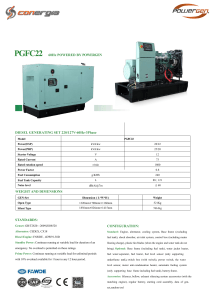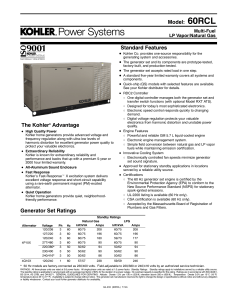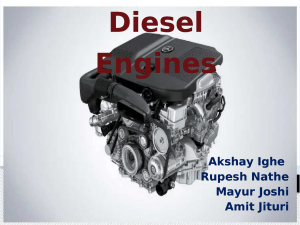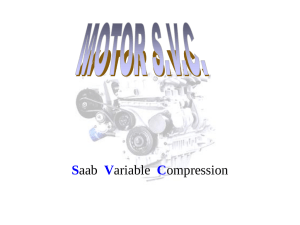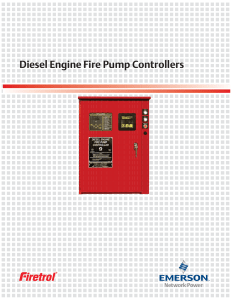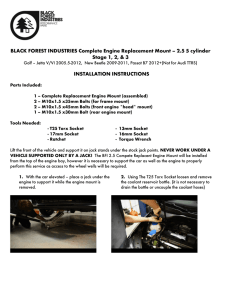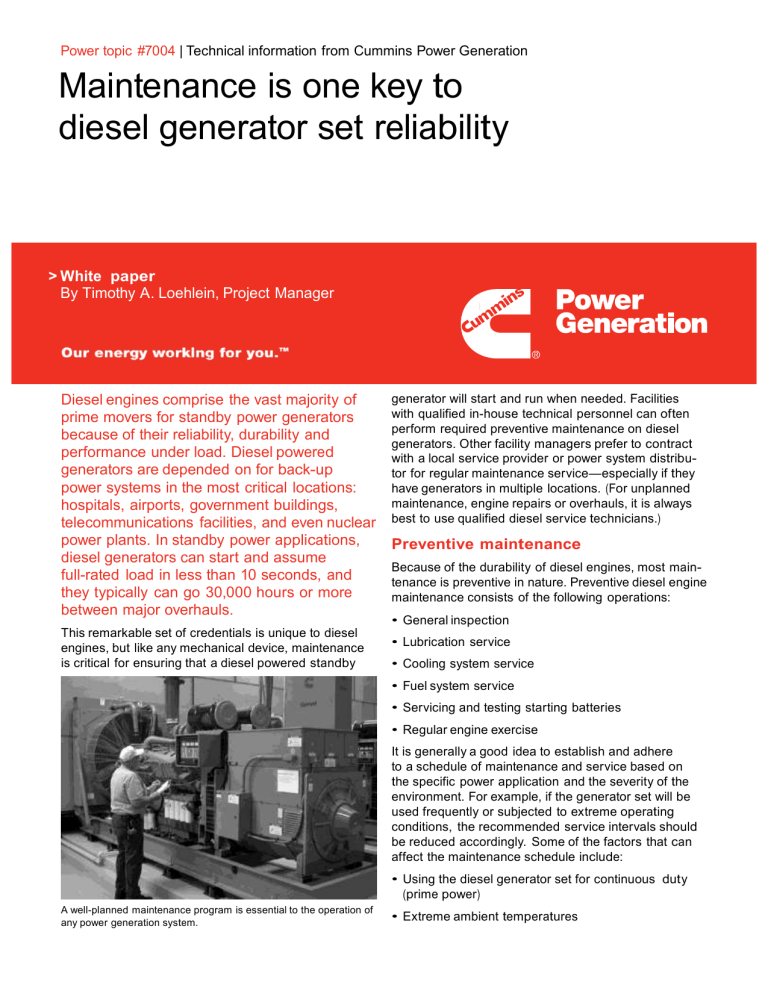
Power topic #7004 | Technical information from Cummins Power Generation Maintenance is one key to diesel generator set reliability > White paper By Timothy A. Loehlein, Project Manager Diesel engines comprise the vast majority of prime movers for standby power generators because of their reliability, durability and performance under load. Diesel powered generators are depended on for back-up power systems in the most critical locations: hospitals, airports, government buildings, telecommunications facilities, and even nuclear power plants. In standby power applications, diesel generators can start and assume full-rated load in less than 10 seconds, and they typically can go 30,000 hours or more between major overhauls. This remarkable set of credentials is unique to diesel engines, but like any mechanical device, maintenance is critical for ensuring that a diesel powered standby generator will start and run when needed. Facilities with qualified in-house technical personnel can often perform required preventive maintenance on diesel generators. Other facility managers prefer to contract with a local service provider or power system distributor for regular maintenance service—especially if they have generators in multiple locations. (For unplanned maintenance, engine repairs or overhauls, it is always best to use qualified diesel service technicians.) Preventive maintenance Because of the durability of diesel engines, most maintenance is preventive in nature. Preventive diesel engine maintenance consists of the following operations: • General inspection • Lubrication service • Cooling system service • Fuel system service • Servicing and testing starting batteries • Regular engine exercise It is generally a good idea to establish and adhere to a schedule of maintenance and service based on the specific power application and the severity of the environment. For example, if the generator set will be used frequently or subjected to extreme operating conditions, the recommended service intervals should be reduced accordingly. Some of the factors that can affect the maintenance schedule include: • Using the diesel generator set for continuous duty (prime power) A well-planned maintenance program is essential to the operation of any power generation system. • Extreme ambient temperatures Power topic #7004 | Page 2 • Exposure to weather General inspection • Exposure to salt water When the generator set is running, operators need to be alert for mechanical problems that could create unsafe or hazardous conditions. Following are several areas that should be inspected frequently to maintain safe and reliable operation. • Exposure to dust, sand or other airborne contaminates If the generator set will be subjected to some or all of these extreme operating conditions, it is best to consult with the engine manufacturer to develop an appropriate maintenance schedule. The best way to keep track of maintenance intervals is to use the running time meter on the generator set to keep an accurate log of all service performed. This log will also be important for warranty support. FIGURE 1 shows a typical diesel engine maintenance schedule for generator sets. Maintenance Items Service time Daily Inspection X Check coolant heater X Check coolant level X Check oil level X Check fuel level X Check charge-air piping X Weekly Monthly 6 Months Yearly X Check battery charger X Drain fuel filter X Drain water from fuel tank X • Engine: Monitor fluid levels, oil pressure and coolant temperatures frequently. Most engine problems give an early warning. Look and listen for changes in engine performance, sound, or appearance that will indicate that service or repair is needed. Be alert for misfires, vibration, excessive exhaust smoke, loss of power or increases in oil or fuel consumption. Check coolant concentration X Check drive belt tension X Drain exhaust condensate X Check starting batteries X Lubrication service Change oil and filter X Change coolant filter X Clean crankcase breather X Change air cleaner element X Check radiator hoses X Change fuel filters X Clean cooling system FIGURE 1 – Typical diesel maintenance schedule. © 2007 | Cummins Power Generation • Fuel system: With the generator set operating, inspect the fuel supply lines, return lines, filters and fittings for cracks or abrasions. Make sure the lines are not rubbing against anything that could cause an eventual breakage. Repair any leaks or alter line routing to eliminate wear immediately. • DC electrical system: Check the terminals on the starting batteries for clean and tight connections. Loose or corroded connections create resistance which can hinder starting. Check/clean air cleaner www.cumminspower.com • Exhaust system: With the generator set operating, inspect the entire exhaust system including the exhaust manifold, muffler and exhaust pipe. Check for leaks at all connections, welds, gaskets and joints, and make sure that the exhaust pipes are not heating surrounding areas excessively. Repair any leaks immediately. Check the engine oil level when the engine is shut down at the interval specified in FIGURE 1. For accurate readings on the engine’s dipstick, shut off the engine and wait approximately 10 minutes to allow the oil in the upper portions of the engine to drain back into the crankcase. Follow the engine manufacturer’s recommendations for API oil classification and oil viscosity. Keep the oil level as near as possible to the “full” mark on the dipstick by adding the same quality and brand of oil. X Change the oil and filter at the intervals recommended in FIGURE 1. Check with the engine manufacturer for procedures for draining the oil and replacing the oil filter. Used oil and filters must be disposed of properly to avoid environmental damage or liability. Power topic #7004 | Page 3 Power system maintenance program A well-planned maintenance program is essential to the operation of any power generation system. Cummins Power Generation offers planned maintenance agreements on all makes and models of generators – regardless of the manufacturer. For customers with fewer than ten generator sets and customers outside the U.S. and Canada, local Cummins distributors Cooling system service Check the coolant level during shutdown periods at the interval specified in FIGURE 1. Remove the radiator cap after allowing the engine to cool and, if necessary, add coolant until the level is about 3/4-inch below the radiator cap lower sealing surface. Heavy duty diesel engines require a balanced coolant mixture of water, antifreeze and coolant additives. Use a coolant solution as recommended by the engine manufacturer. Inspect the exterior of the radiator for obstructions and remove all dirt or foreign material with a soft brush or cloth. Use care to avoid damaging the fins. If available, use low pressure compressed air or a stream of water in the opposite direction of normal air flow to clean the radiator. Check the operation of the coolant heater by verifying that hot coolant is being discharged from the outlet hose. Fuel system service Diesel fuel is subject to contamination and deterioration over time, and one reason for regular generator set exercise is to use up stored fuel over the course of a year before it degrades. In additional to other fuel system service recommended by the engine manufacturer, the fuel filters should be drained at the interval indicated in FIGURE 1. Water vapor accumulates and condenses in the fuel tank and must also be periodically drained from the tank along with any sediment present. www.cumminspower.com © 2007 | Cummins Power Generation are nearby to provide a comprehensive maintenance program tailored to your needs. For customers in the US and Canada with more than ten gensets, Cummins Power Generation offers PowerCare® Advantage—your single source for preventative power system maintenance. PowerCare Advantage provides proactive maintenance, 24-hour emergency service, consolidated billing and online management reporting—all from one source. The charge-air piping and hoses should be inspected daily for leaks, holes, cracks or loose connections. Tighten the hose clamps as necessary. Also, inspect the charge-air cooler for dirt and debris that may be blocking the fins. Check for cracks, holes or other damage. The engine air intake components should be checked at the interval indicated in FIGURE 1. The frequency of cleaning or replacing air cleaner filter elements is primarily determined by the conditions in which the generator set operates. Air cleaners typically contain a paper cartridge filter element which can be cleaned and reused if not damaged. Starting batteries Weak or undercharged starting batteries are the most common cause of standby power system failures. Even when kept fully charged and maintained, lead-acid starting batteries are subject to deterioration over time and must be periodically replaced when they no longer hold a proper charge. Only a regular schedule of inspection and testing under load can prevent generator starting problems. See FIGURE 1 for the recommended inspection interval for the batteries and charging system. • Testing batteries: Merely checking the output voltage of the batteries is not indicative of their ability to deliver adequate starting power. As batteries age, their internal resistance to current Power topic #7004 | Page 4 About the author Timothy A. Loehlein is a graduate of the University of Minnesota with a Bachelor of Electrical Engineering and a PE in Minnesota. Tim has been a Cummins Power Generation employee since 1976 in positions as Application Engineer, flow goes up, and the only accurate measure of terminal voltage must be done under load. This test is performed automatically every time the generator is started on Cummins Power Generation generator sets equipped with PowerCommand®. On other generators, use a manual battery load tester to verify the condition of each starting battery. • Cleaning batteries: Keep the batteries clean by wiping them with a damp cloth whenever dirt appears excessive. If corrosion is present around the terminals, remove the battery cables and wash the terminals with a solution of baking soda and water (1/4-pound baking soda to one quart of water). Be careful to prevent the solution from entering the battery cells, and flush the batteries with clean water when done. After replacing the connections, coat the terminals with a light application of petroleum jelly. • Checking specific gravity: Use a battery hydrometer to check the specific gravity of the electrolyte in each battery cell. A fully charged battery will have a specific gravity of 1.260. Charge the battery if the specific gravity reading is below 1.215. • Checking electrolyte level: Check the level of the electrolyte in the batteries at least every 200 hours of operation. If low, fill the battery cells to the bottom of the filler neck with distilled water. www.cumminspower.com © 2007 | Cummins Power Generation and Cummins are registered trademarks of Cummins Inc. “Our energy working for you.” is a trademark of Cummins Power Generation. PT-7004 (04/07) Formerly PT-302 Design Engineer, Technical Project Leader and Project Manager. His current position is a Technical SpecialistElectrical in application engineering for Cummins Energy Solutions Business, supporting combined heat and power (CHP) and peaking applications. Generator set exercise Generator sets on continuous standby must be able to go from a cold start to being fully operational in a matter of seconds. This can impose a severe burden on engine parts. However, regular exercising keeps engine parts lubricated, prevents oxidation of electrical contacts, uses up fuel before it deteriorates, and, in general, helps provide reliable engine starting. Exercise the generator set at least once a month for a minimum of 30 minutes loaded to no less than one-third of the nameplate rating. Periods of no-load operation should be held to a minimum, because unburned fuel tends to accumulate in the exhaust system. If connecting to the normal load is not convenient for test purposes, the best engine performance and longevity will be obtained by connecting it to a load bank of at least one-third the nameplate rating. Conclusion Preventive maintenance for diesel engine generators plays a critical role in maximizing reliability, minimizing repairs and reducing long term costs. By following generally recognized diesel maintenance procedures and specific manufacturer recommendations for your application, you’ll be assured that your standby power system will start and run when you need it most. For additional technical support, please contact your local Cummins Power Generation distributor. To locate your distributor, visit www.cumminspower.com.
![MTU SERIES 60 MARINE[1]](http://s2.studylib.es/store/data/009437511_1-a3e64a9d50ce320d33d006c4e06868c4-300x300.png)
